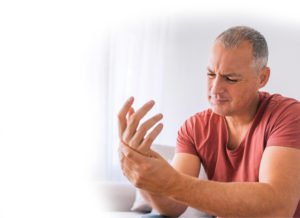By Alfred R. Roach, Jr. –
 As a child visiting my grandparents, I often heard my Granddad Jack refer to Arthur Itis. Although I never met the man, I knew that my granddad really didn’t like him. Several years later I learned that Arthur was not a man that my granddad complained about, but a painful health condition he suffered from, called “arthritis”. So, this article is dedicated to Granddad Jack and his buddy “Arthur”.
As a child visiting my grandparents, I often heard my Granddad Jack refer to Arthur Itis. Although I never met the man, I knew that my granddad really didn’t like him. Several years later I learned that Arthur was not a man that my granddad complained about, but a painful health condition he suffered from, called “arthritis”. So, this article is dedicated to Granddad Jack and his buddy “Arthur”.
Contrary to popular belief, arthritis is not just a condition for us “Boomers”. Although it is more prevalent in those of us over 45, arthritis is non-discriminatory. With one out of every seven Americans having some form of arthritis, it picks on male and females, and children and adults.
Arthritis is among the oldest afflictions of human beings and has been found in the mummies of Egypt. The term “arthritis” means inflammation (“itis”) of the joints (“arthro”). It causes pain, swelling, and limited mobility which if not treated properly can progress to chronic pain, life style restrictions, disabilities, and dependence on others.
While there are over 100 different forms of arthritis (considered a rheumatic disease), the two most prevalent forms are osteoarthritis and rheumatoid arthritis. While rheumatoid arthritis is the most difficult to control, osteoarthritis (also know as degenerative joint disease) is the most common form and causes inflammation and damage to the body’s cartilage tissue. Cartilage is the “slippery” tissue that sits at the ends of our bones, allowing our bones to work smoothly where they meet the joints. When the cartilage is damaged, the uncushened bones and joints rub against each other causing the pain and swelling.
Before we go any further, let’s make sure that we don’t overreact when we experience some pain. The process of everyday living will result in some physical pain and discomfort, and more often than not, it doesn’t mean that it is caused by arthritis. It can simply be the result of a game of golf or tennis, or by just doing house or yard work. How can we tell the difference? Here are some of the indications that the pain may be caused by arthritis:
. The pain persists beyond three days
. The joint pain is severe and unexplained
. The painful joint is significantly swollen
. The joint is hard to move
. The skin around the joint is red or hot to touch
. You have a fever or have an unexplained loss of weight
With any of these symptoms, you should contact your health care provider. Generally, only an X-ray can confirm the presence of osteoarthritis.
Although aging (45 and older) is considered to be one of the risk factors or causes of arthritis, there are several others:
. Genetics. It is believed that family heritage could play a role in as much as 25 to 30 percent of osteoarthritis cases.
. Overweight. Excess weight puts undo stress on the joints.
. Weak muscles, like your quadriceps (those large
muscles in the front of your legs above your knees) can put undo stress on the joints they support.
. Joint trauma. Previous injuries can cause weakness to the bones and joints.
. Severe use or abuse of the joints – both recreational and occupational.
. Infections.
. Autoimmune diseases.
. Certain other illnesses.
While we can’t do anything about our age or our genetics, here are some steps we can take to deal with these other risk factors and causes. Some of these lessen the severity of the arthritis and the corresponding pain and others can actually prevent the disease from occurring:
. Try RICE to allow the symptoms to subside.
RICE is an easy reminder of the pain-relieving sequence of Rest, Ice, Compression, and Elevation.
. If you are overweight, studies show that a loss of as little as ten pounds can help reduce the pain and even reduce the chance of developing arthritis.
. Diets rich in vitamins and calcium.
. Supplements such as glucosamine and chondrotin.
. Physical therapy, which is typically recommended for rheumatoid arthritis.
. Over-the counter and physician-prescribed medications, which unfortunately always seem to come with a long list of potential and sometimes troubling side effects. It is recommended that you should only take these medications with the prior approval or prescription from your health care provider.
. Injecting the joint with a manmade version of the natural synovial fluid that lubricates the joints.
. Surgery to rebuild (arthoplasty) or replace the joint (such as total knee joint replacement).
The best treatment and possible preventative of arthritis is to live an active life style, getting regular exercise. This recommendation will surprise some of you due to a common misconception that exercise can aggravate and even cause arthritis. But research continues to show that regular exercise, and especially weight-bearing strength exercise, is an “essential” tool in managing and even preventing arthritis. These studies indicate that high intensity, weight bearing strength training builds and maintains the muscles that are the “shock absorbers” protecting our joints. In addition, this controlled form of exercise is shown to help the joints absorb the important nutrients from the synovial fluids that “oil” the joints and stimulate the development of the cartilage. A recent strength training study at Tufts University showed that people with severe knee osteoarthritis decreased their pain by 40%. And they even found that this training helped in cases of the more complex rheumatoid arthritis.
So here we are – “boomers” and all. We have our aches and pains – some harmless, some need our attention. Bottom line – listen to your body. It will tell you when something is wrong. Just do what our parents have always told us to do (but sometimes didn’t always do themselves): Eat right, work hard, get plenty of rest, get regular checkups, commit to regular weight bearing exercise, and above all – avoid Arthur!
For more about arthritis, go to the Arthritis Foundation’s web site at www.ArthritisFoundation.org.
Alfred R. Roach, Jr. and his wife, Virginia Phillips, are owners of 20 Minutes to Fitness ®, a private strength training studio located in Lakewood Ranch. Training sessions are individually supervised by certified personal trainers and are by appointment only. Telephone: 941.309.8989. Web site: www.20minutetofitness.com








